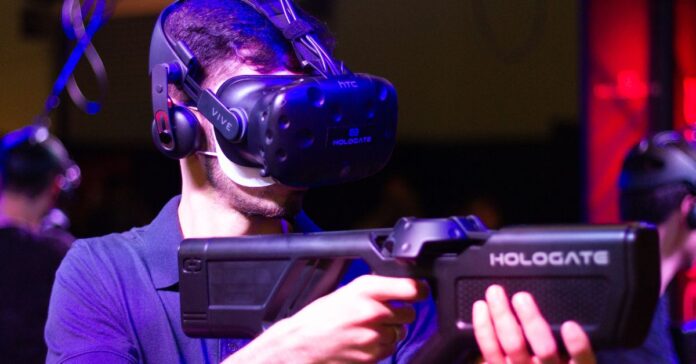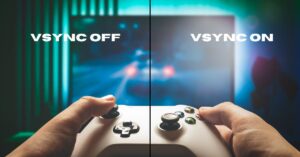VSync is short for Vertical Synchronization, a graphics technology that synchronizes the fram率te of a game to the refresh rate of a monitor. It mainly eliminates screen tearing, which is a visual artifact in which the screen displays multiple frames all in one screen draw, thus giving the impression of the screen “tearing” horizontally. Screen tearing is rather annoying and distracts from the whole gaming experience, hence making what is VSYNC beneficial for many gamers.
VSYNC controls data transfer from the graphics card to the monitor, ensuring that a new frame is sent only when the monitor is ready to show it. While VSYNC can significantly improve the appearance of a video game, the pros and cons of this technology will be important to understand, particularly for those who need to decide whether to turn it on during certain gaming sessions.
What is VSYNC in Games?
Speaking of which, for gaming itself, VSYNC is pretty much the backbone for rendering smooth, visually fascinating gameplay. VSync turned on works to match the frames that come from the graphics card with the refresh rate of the monitor, normally 60 Hz, 120 Hz, or more. This helps avoid screen tearing and can make animations smooth.
However, VSYNC sometimes turns on input lag, a delay between the player’s input and what is happening as an outcome of that on the screen. This happens because the graphics card has to wait for the refresh cycle to end of the monitor to send out the next frame. The input lag would be much more evident in fast-movement games, such as first-person shooters, where reaction time plays an important role.
What is VSYNC in Minecraft
The VSYNC option within Minecraft can be quite useful, especially for those who get screen tearing within the game. This Minecraft VSYNC option turns on when your video frame rate is synchronized with the refresh rate of your monitor for a smoother visual experience in the game. These changes can definitely be worth considering for those with lower refresh rate monitors or older graphics hardware that struggles to maintain consistent framerates.
However, some Minecraft gamers also prefer turning off VSYNC in order to maximize their frame rates, especially when they use high-refresh-rate monitors and advanced graphics cards. In these cases, screen tearing may be less noticeable or more bearable than the benefit brought by ultra-high frame rates.
VSYNC vs G SYNC
While VSYNC is a standard feature that is implemented in most monitors, G-SYNC is a proprietary technology of NVIDIA that has yielded a more advanced solution to screen tearing and stuttering. How G-SYNC works is it dynamically changes the refresh rate of the monitor to match the frame rate output of the graphics card, virtually eliminating screen tearing and reducing input lag.
The key difference between VSYNC and G-SYNC is how they approach frame synchronization management. VSYNC clips the frame rate to the refresh rate of the monitor, usually engendering input lag when it cannot maintain high performance by the graphics card. G-SYNC dynamically adjusts the refresh rate of the monitor in real time, matching the frame rate for a much smoother experience devoid of all negative effects associated with input lag.
VSYNC vs FreeSync.
FreeSync is another form of adaptive synchronization technology, albeit developed by AMD in a manner much like G-SYNC. In theory, it works much the same way as G-SYNC, varying the monitor’s refresh rate according to the graphics card output to reduce tearing and stuttering without greatly increasing input lag.
The primary difference between FreeSync and G-SYNC refers to compatibility issues and, consequently, the price of the products. FreeSync is an open standard and tends to be offered in lower-priced monitors than G-SYNC, which relies on specific hardware to enable it, usually making the monitor more costly. When comparing VSYNC against FreeSync, it is evident that FreeSync offers a superior experience with fewer drawbacks, thus becoming a better option for most gamers.
VSYNC Input Lag
One of the biggest complaints about VSYNC is that it creates input lag. This happens because VSYNC essentially forces the graphics card to wait until the monitor is ready to display a new frame, which can cause serious delays between the time a button is pressed and the time it shows up on screen. For fast-paced competitive games, this kind of input lag is a real detriment.
To help reduce this VSYNC input lag, many games and their graphics drivers offer a feature called “Triple Buffering” that allows the graphics card to store an additional frame in the buffer. This can make frame delivery much smoother and reduce lag, but it isn’t a complete solution to the problem. Those sensitive to input lag are often better off disabling VSYNC altogether.
So here is also the information about basketball games
VSYNC benefits
Even with the possibility of input lag, VSYNC has many advantages that make it worth considering in many different gaming contexts:
Prevents Screen Tearing: The most important feature of VSync is to prevent the screen from the most irritating occurrence in gameplay.
Smoothes out visuals: VSYNC maintains visuals smoothly, particularly when the frame rates go all over the place.
Reduces GPU Stress: In doing so, VSYNC can reduce the burden on the GPU by capping the frame rate to the refresh rate of the monitor, which may lower its power consumption and heat output.
Smoothening of Movie Effect: In the case of slower-paced games, like story-driven adventure or even simulation games, VSYNC enhances visual appeal by allowing animation and movement to come out smoothly.
Improved Compatibility with Legacy Displays: VSYNC enables high-performance GPUs to be used along with older monitors that may exhibit screen tearing problems at high frame rates.
VSYNC On or Off?
The decision to enable or disable VSYNC is contingent upon the genre of the game being played, the specifications of your hardware, and your personal tolerance for screen tearing in contrast to input lag. In the case of visually demanding, slower-paced games, activating VSYNC can significantly improve the gaming experience by removing tearing and stuttering.
Conversely, in competitive gaming scenarios where rapid responses are essential, the input lag associated with VSYNC may prove to be a significant disadvantage. In those cases, the player might benefit more from disabling VSYNC and putting up with minor screen tearing, or searching out newer technologies like G-SYNC or FreeSync, which offers superior performance without the associated downsides.
Vertical Synchronization in Gaming
VSYNC in gaming, better known by its colloquial abbreviation Vertical sync, has been a staple among gamers-a simple, yet effective solution to screen tearing. While newer technologies such as G-SYNC and FreeSync allow for better performance with these, VSYNC is still relevant today, especially to budget gamers or those using older hardware.
This is where VSYNC can bring smooth and beautiful gaming experiences when used properly. However, understanding when to use it and how is key for maximum benefits while reducing the side effects that might come with it, such as input lag
QnA
1. What is VSYNC?
VSYNC: This stands for Vertical Synchronization, a technology that synchronizes a game’s frame rate with the monitor’s refresh rate to avoid tearing.
2. Does VSYNC cause input lag?
VSYNC can indeed cause input lag since it makes the graphics card wait for the refresh cycle of the monitor before sending the next frame out.
3. Should I enable or disable VSYNC?
It depends on the game and your preferences. Turn it on to reduce screen tearing in slower-paced games, but consider turning it off in fast-paced or competitive games where input lag is a concern.
4. What is the difference between VSYNC and G-SYNC?
VSYNC works by synchronizing frame rates to the refresh rate of a monitor, while G-SYNC dynamically adjusts the monitor refresh rate to match the graphics card output for less tearing and lag.
5. Is FreeSync superior compared with VSYNC?
FreeSync is generally considered better than VSYNC as it provides smoother gameplay without the input lag associated with traditional VSYNC.













